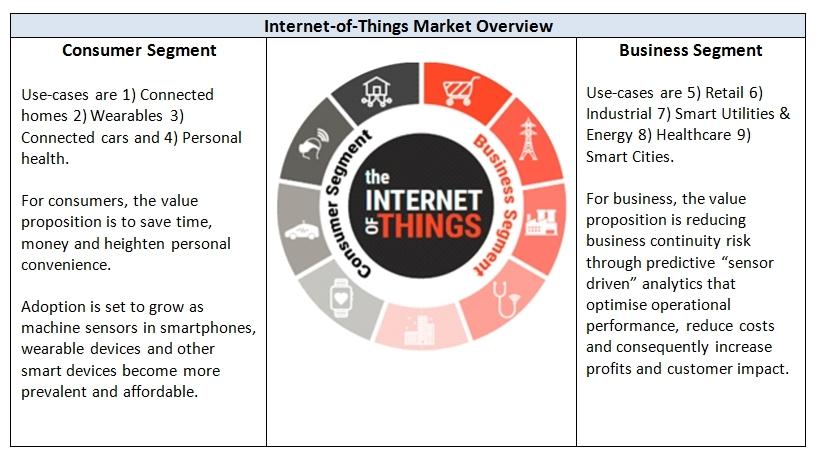The Ericcson 2017 Mobility Report forecasts that by 2023, there will be over 30 billion connected devices, of which around 20 billion will be related to the Internet of things (IOT).
Connected IOT devices include connected cars, machines, meters, sensors, point-of-sale terminals, consumer electronics and wearables. Between 2017 and 2023, connected IOT devices are expected to increase at a CAGR of 19%, driven by new use cases and affordability.
IOT market in perspective
According to the 2017 Growth Enabler Market Pulse Report for IOT, IOT serves two distinct user groups: business and individuals. These two user-groups can then broadly be classified into nine segments, as shown in the following diagram:

Communication network perspective
The Ericcson communication analysis divides the IOT market into short-range and wide-area segments. The short-range segment largely consists of devices connected by unlicensed radio technologies, with a typical range of up to 100 metres, such as WiFi, Bluetooth and Zigbee. This category also includes devices connected over fixed-line local area networks and powerline technologies.
The wide-area segment consists of devices using cellular connections, as well as unlicensed low-power technologies, such as Sigfox and LoRa. At the end of 2017, an estimated 0.5 billion IOT devices were connected with cellular connections. This number is projected to reach 1.8 billion in 2023, or around 75% of the wide-area category.

By 2023, the short-range segment is expected to be 17.4 billion devices or 55% of the connected devices market. What is not made very clear in the Ericcson analysis is that part of short-range communication network architecture is a wide-area network circuit that connects the "on-site" short range network with the centralised cloud infrastructure. Each and every WiFi, Bluetooth or Zigbee network deployed on a user campus must also be integrated with a reliable backhaul link.

For any "off-grid" location, ie, a location which is not connected to the national telco mobile or fixed-line telecommunication grid, this backhaul connectivity must be provided by satellite or wireless alternative infrastructures. Based on an estimate that 10% of locations will be "off-grid", this represents a need for alternative connectivity for 1.7 billion devices - almost the same as planned to mobile networks!
Conclusion
The IOT will certainly change the way we work, play and live. The user applications and business benefits will be developed to change our reality and the way we experience the world around us.
As can be expected, the fundamental requirement for this change to materialise is the need for reliable and scalable connectivity. With the wide footprint of cellular networks, and the dominance of 3G as a connectivity medium, Ericcson forecast the 1.8 billion devices will be connected via cellular networks.
However, based on the total market forecast, it is expected that 1.7 billion devices will be operating from "off-grid" locations and will have to be connected using alternative networks such as satellite. It is thus expected that satellite and cellular networks will have equal share in the IOT connectivity sector.
Share